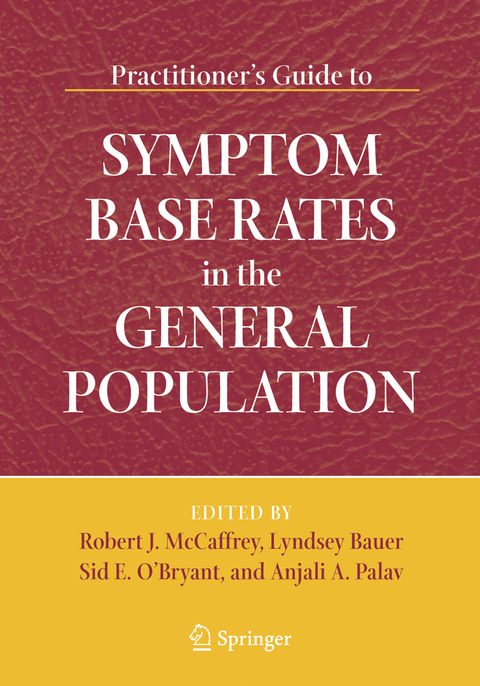
Practitioner's Guide to Symptom Base Rates in the General Population
Springer-Verlag New York Inc.
978-0-387-26757-9 (ISBN)
SUMMARY Meehl and Rosen (1955) Wrst demonstrated the importance of base rates in psychologicalassessmentnearlyWvedecadesago. Theseauthorsstated,"Thechief reasonforourignoranceofthebaseratesisnothingmoresubtlethanourfailureto computethem"(pg. 213). Researcherscontinuetoreportthatbaseratesarestill largelybeingignored(Duncan&Snow,1987;Gouvier,Hayes,&Smiroldo,1998). It isbecauseofthisgapintheliteraturethatthecurrentbookPractitioner'sGuideto SymptomBaseRatesintheGeneralPopulationandthepreviousbookPractitioner's GuidetoSymptomBaseRatesinClinicalNeuropsychology(McCaVreyetal. 2003) werecreated. Ifthediagnosticaccuracyofourclinicaldecision-makingprocessand ourtestinginstrumentsaretobeestimated,wemustcalculatethebaseratesofthe symptoms,disorders,anddiseasesweassessforonaregularbasis. Itishopedthatthepresentbookwillaidneuropsychologicalpractitionersand otherhealthcareprofessionalsintheevaluationofthepresentingcomplaintsoftheir patients. Baseratesareofutmostimportanceintheestimationofdiagnosticaccuracy ofneuropsychologicalandpsychologicalassessment,aswellasanyotherformof testing,aswellasintheinterviewanddiVerentialdiagnosticprocess.
Itishopedthat thesetwovolumeswillencourageadditionalresearcherstoreportbaserateinfor- tion as well as detailed information regarding the population from which this informationwasobtained. Inordertoestimatetheaccuracyofourclinicaldi- noses/decisionsthataremadeonadailybasis,wemustunderstandtheimportanceof baserateinformationandmakeeveryattempttocollectandreportthisdata. Last, thecurrentintroductionismeanttoprovideabriefoverviewofbaseratesandtheir utilityinclinicalneuropsychology. Ifthereaderwishestogainmoredetailedund- standing regarding base rates s/he is referred to Practitioner's Guide to Symptom BaseRatesinClinical Neuropsychology(McCaVrey,Palav,O'Bryant,&Labarge, 2003)aswellasothersources(e. g. ,Gordon,1977;Gouvier1999,2001;Meehl& Rosen,1955). Key for Using Tables Gender: Males/Females Age: Mean (Standard Deviation); Range Race: Caucasian/African American/Hispanic/Asian Native American/Other Timeframe: timeframe of symptom report SAMPLE TABLE CHARACTERISTICS Schaughency, et al.
(1994) n = 943 Diagnostic Criteria: Gender: 483/460 Age: 15 Race: Population Setting: community Nationality: New Zealand Other Sample Characteristics: Method of Reporting: self-report Timeframe: current 5 II / Control Groups: Adult COLLEGE STUDENTS Machulda, et al. (1998) Population Setting: college n = 141 undergraduates Diagnostic Criteria: Nationality: US Gender: 49/92 Other Sample Characteristics: Age: 20. 7 (18-22) Method of Reporting: self-report Race: 268/88/66/7/0/9 Timeframe: Symptom % Symptom % anxiety 87 headache 57 concentration difference 80 irritability 74 depression 71 sensitive to light 26 disordered sleep 41 sensitive to sound 16 dizziness 19 fatigue 83 Freeston, et al. (1996) Population Setting: university n = 583 undergraduates Diagnostic Criteria: Nationality: Canada Gender: 216/367 Other Sample Characteristics: Age: 22. 6 (4. 6) Method of Reporting: self-report Race: 268/88/66/7/0/9 Timeframe: Symptom % Symptom % difficulty concentrating or 16. 5 muscle tension, aches, or 17.
Dr. Robert McCaffrey is a Professor of Psychology at the State University of New York in Albany. He is a leading figure in the neuropsychology community, a Diplomate of the American Board of Professional Neuropsychology and the American Board of Professional Disability Consultants. He is also a Fellow of the National Academy of Neuropsychology and the American College of Professional Neuropsychology. In 2006 he will assume editorship of the journal Neuropsychology Review. His coauthors are also in the Department of Psychology at SUNY-Albany.
A Brief Overview of Base Rates.- Control Groups: Adult Control Groups.- College students.- Combat veterans.- Community members.- Family practice.- General practice patients.- Internal medicine.- Litigants.- Medical and Dental students.- Neurology.- Nonsmokers.- Normal.- Occupational.- Psychiatric adults.- Child and Adolescent Control Groups.- Clinic referred children.- Delinquents.- Elementary school children.- High school students.- Psychiatric referred children.- Secondary school students.- Special Education students.- Elderly Control Groups.- Alzheimer’s disease spouses.- Frail elderly.- Nursing home.- References.- Symptom Index.
| Erscheint lt. Verlag | 5.1.2006 |
|---|---|
| Zusatzinfo | VII, 236 p. |
| Verlagsort | New York, NY |
| Sprache | englisch |
| Maße | 178 x 254 mm |
| Themenwelt | Geisteswissenschaften ► Psychologie ► Biopsychologie / Neurowissenschaften |
| Geisteswissenschaften ► Psychologie ► Klinische Psychologie | |
| Medizin / Pharmazie ► Medizinische Fachgebiete ► Neurologie | |
| Medizin / Pharmazie ► Studium | |
| ISBN-10 | 0-387-26757-3 / 0387267573 |
| ISBN-13 | 978-0-387-26757-9 / 9780387267579 |
| Zustand | Neuware |
| Haben Sie eine Frage zum Produkt? |
aus dem Bereich


